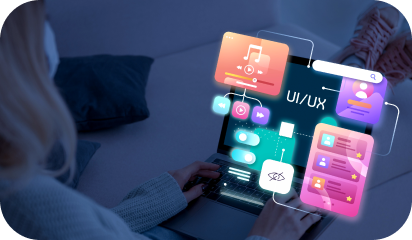The sudden change in lifestyles; professional and otherwise, has made remote work critical for many fields around the world, including UX testing.
Remote user testing has been there in the process since many years making sure that our users are having the best possible experience with our product. Especially mostly by those business organizations who reckon the fact that consumer-centric products sell better.
Although the biggest challenge is not the geographic distance while performing user testing. It’s instead, planning the right strategy, finding the right participants, and communicating with the right tools available. Absence of which can have a negative influence on testing results.
Choose the type of user testing that fits your need
There are two main types of remote usability tests, among which you should select one according to your need and to further validate your designs.
Moderated remote testing
In this type of testing you and the participant both communicate via phone or video conferencing software.
This technique is often used earlier in the design process that allows you to offer support in real-time and ask further questions for deeper clarification from the users as particular issues arise.
Unmoderated user testing
These tests are completed through survey forms mostly alone by the participant, without any phone or video call.
It works well while testing a few specific elements in a time and budget crunch, like a particular widget or a minor change.
Since every business is going user-centric, moderated remote testing has been adopted to interact directly with the target audience and gain a rich understanding of their goals and pain points.
So, if it suits your testing needs to gently nudge a quiet participant to share more about what he’s doing, then here are the best practices of shifting from in-person to easy going and cost efficient remote user testing.
Plan your ultimate testing goal
Define your target user and decide which specific areas of your site or app you plan on testing. In your test prep meeting remotely, discuss the agenda to focus on the goals of testing. It’s important to:
- Develop straightforward tasks that have well-defined end states.
- Prepare introductory and/or test materials so the participants will know what is expected of them as well as what they can expect from you.
- Define the turnaround time of user testing, defining number of participants for each session.
- Craft good task scenarios that are clear to your participants and have no ambiguity in understanding what you want them to do.
Explore mediums to recruit right testers
Since tests are remote, you are able to recruit people from just about anywhere! It is important to make sure they are representative of your target audience as you are choosing from a pool of participants around the world. There are ways where you can find them:
- Social media channels such as LinkedIn, Twitter, and Facebook are good options for contacting people who may be interested in testing out your product/prototype.
- There are a number of recruiting services that exist out there. Some are traditional where live representatives contact users from all over the place and screen them based on your requirements.
- Others are almost fully automated web-based services where you can basically run a recruitment project on your own just by a few clicks, and potential candidates are automatically added to your project and ready for your approval.
How many participants do I need?
You want to avoid recruiting too few users yielding in insufficient results; nor do you want to recruit too many users and waste time and resources on additional tests.
It’s always better to learn from 6-8 users for each user role, update the design to fix the issues identified, and then test again.
But as a general guideline, if you are on a small budget and interested in DIY usability testing, 5 is a good number to start with. If budget is not a constraint its best to consult experienced professionals to determine the number of users.
Arrange Session and Kick-off Call
Join over a call with your participants using software like Zoom, GoToMeeting, or Lookback. (Stakeholders and other observers can join too). After a brief introduction to explain the setup and establishing rapport, share your screen with the participant, give them control of it, and ask them to complete tasks while thinking aloud.
Observe the participant’s actions, hear their commentary, and see their facial expressions (if webcams are on).
Ask probing questions to explore the participant’s understanding of the interface, just as if you were sitting beside them. Identify and diagnose any usability problems in the design.
Based on those insights, you can provide concrete, actionable recommendations for improving the product’s user experience – all without anyone leaving their homes.
How Costly is Remote User Testing?
Getting a moderator, participants and the product in the same room for about an hour per participant can get really expensive. Expensive enough that this kind of user testing is just not within the reach of many designers.
Moderated remote testing helps with the nasty bills by allowing the moderator to interact with users online through sharing screens instead of face-to-face. Even by choosing a relatively expensive user testing tool, the cost of on-site and remote testing can seldom be compared.
Conclusion
In a global situation like this, when you’re under pressure with deadlines looming – usability might seem trivial enough to skip. Don’t make this mistake: it will cost you more in the long run. Usability testing will, of course, require a degree of investment in time and money, but it pays off.
Remote usability testing has become more and more popular as companies work to cut costs without sacrificing the ability to gain insight into future product success. It is up to us UX designers to know the in’s and out’s of this methodology in order to utilize it most effectively.

